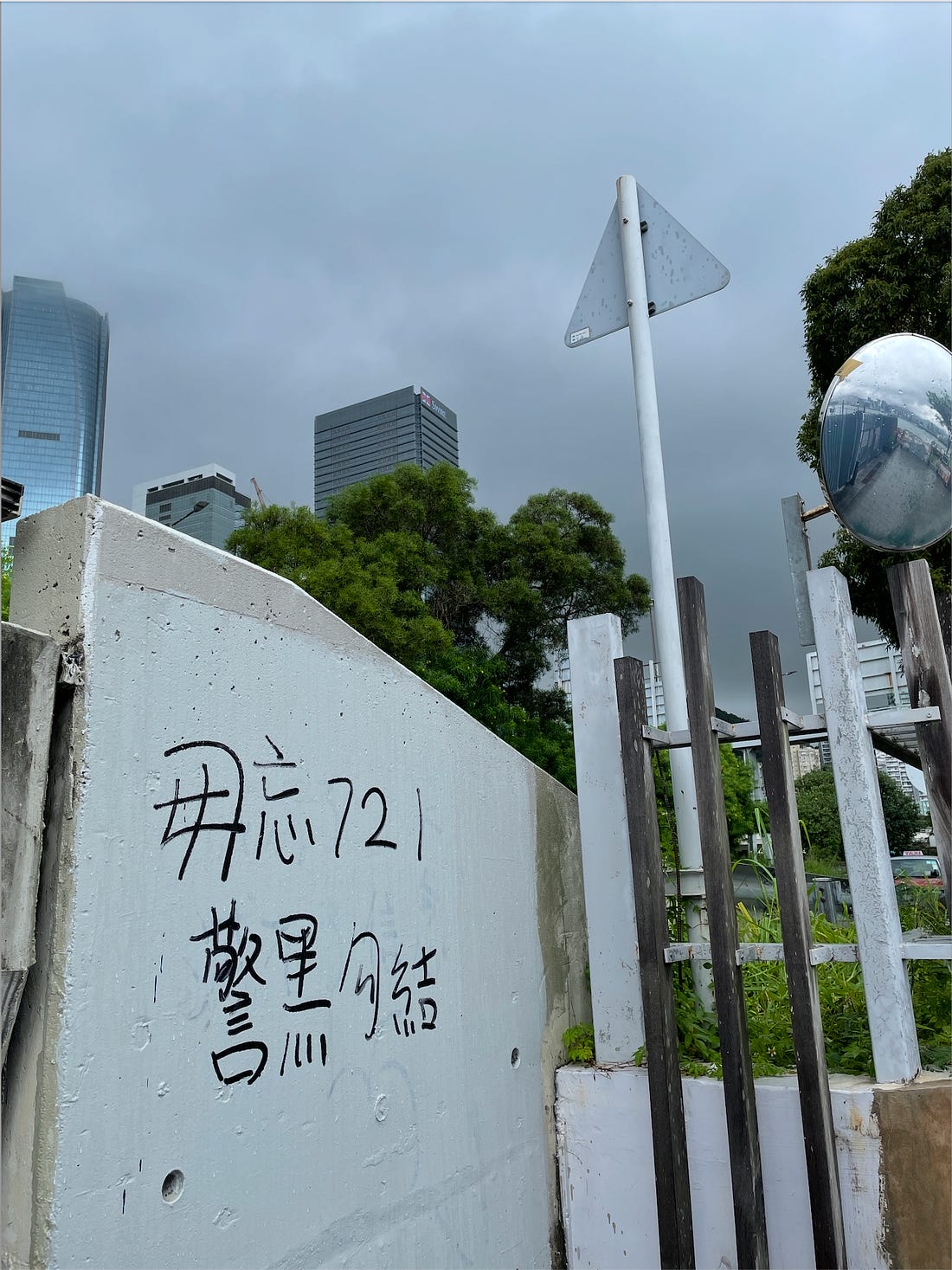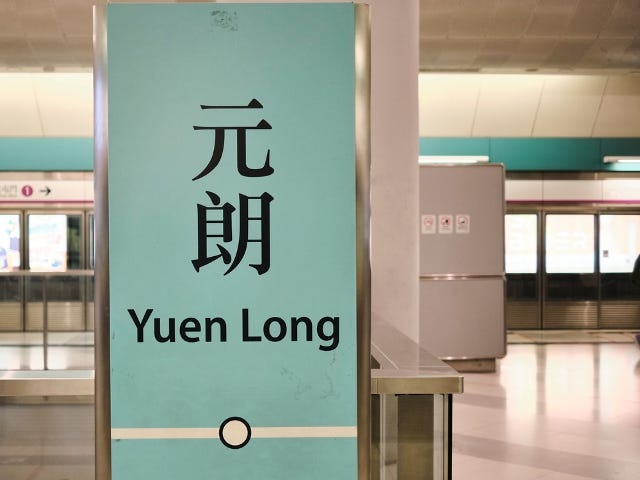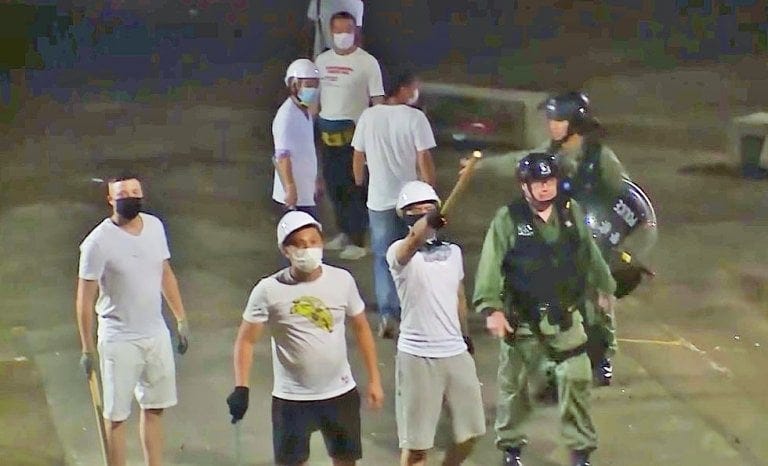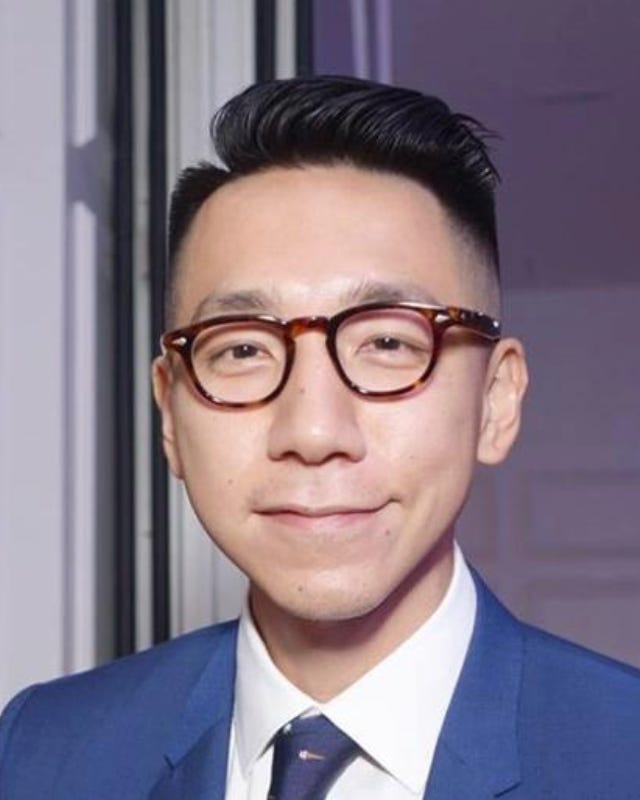Remembering the 7/21 Yuen Long Attack: Preserving the Spark of Justice Through Memory
By Fu Chan
[中国民间档案馆 China Unofficial Archives is a reader-supported publication. To receive new posts and support our work, please consider becoming a free or paid subscriber through the above link.]
Six years ago, on July 21, 2019, protests entered a second month against the Hong Kong government’s efforts to introduce a law making it easier to extradite people to Mainland China. That night and into the early hours of the next morning, gangs of men clad in white entered the Yuen Long MTR station in the city’s northwest and beat up civilians. The violent attacks were a stark awakening for many Hong Kongers, making it clear that the protests would no longer proceed peacefully—a turning point that imperiled Hong Kong’s existence as a free city.
Lau Chun Kong was among those Hong Kongers deeply concerned about the extradition bill and a victim of the 7/21 Yuen Long attack. Born in 1981, Lau entered Hong Kong’s news industry at a young age. From 2002 to 2010, he worked as a reporter and anchor for Hong Kong’s TVB (Television Broadcasts Limited) network, with postings in Beijing and Guangzhou, covering numerous major news stories in Mainland China. Following the Wenchuan earthquake in 2008, Lau and his Hong Kong journalist colleagues trekked for two days, becoming the first non-Mainland journalists to reach Yingxiu Town, the earthquake’s epicenter. Lau later left journalism to take up public relations duties with the Society for the Prevention of Cruelty to Animals and Kowloon Motor Bus.
But after being attacked on 7/21, Lau returned to his journalistic roots. He interviewed over forty witnesses and shared his own experiences, creating a historical testament: Dark Night in Yuen Long: My Memories and the Crowd’s Memories.
A Journalist’s Calling: Reconstructing the 7/21 Yuen Long Attack
Many of the facts about the 7/21 Yuen Long attack documented in Dark Night in Yuen Long were captured by cell phone cameras during the incident. Lau added to the investigation by verifying other eyewitness accounts.
On July 21, 2019, as hundreds of thousands of Hong Kong citizens participated in peaceful marches across the city, several hundred white-clad individuals, allegedly with triad connections and armed with wooden sticks, rattan canes, and other weapons, had already begun gathering in Yuen Long District in northwestern Hong Kong.
As night fell, these white-clad men twice stormed the Yuen Long MTR station, attacking citizens and indiscriminately assaulting passengers on a train. They also damaged vehicles and injured residents around Yuen Long station, resulting in nearly 50 people being injured and hospitalized. Despite the late hour, news of the attack spread rapidly online. Images of bloodstained train compartments and the sounds of crying and shouting created a collective, terrifying memory for Hong Kongers.
However, people quickly realized this was not merely a unilateral act of gang violence. The perpetrators had been gathering with weapons since daylight and assaulting citizens into the night, a period spanning over half a day. That evening, Hong Kong police received tens of thousands of emergency calls.
Yet, from the gangs’ initial assault on Yuen Long MTR station to the time citizens were attacked and injured, it took the police 39 minutes to arrive at the scene. They then passed by the departing perpetrators, who were leaving the station. Once present, the police confronted the indignant citizens and observed the bloodstained train platform without preserving the scene or immediately collecting evidence, leaving shortly thereafter.
For a period of time after midnight, the police disappeared again. During this time, the gangs continued to attack citizens around Yuen Long station and again stormed the MTR station, injuring more people. That night, the Hong Kong police did not arrest any perpetrators.
The Hong Kong police’s series of highly unusual actions led many Hong Kongers to suspect that the 7/21 violent attack was the result of what some called “police-triad collusion.” This implied that Hong Kong triad forces were either instructed or tacitly allowed by the police, the Hong Kong government, or even China’s central government to attack Hong Kong citizens. The intent was to instill fear for personal safety among Hong Kongers, thereby discouraging further street protests. (Indeed, when a citizen called the police that night, a Yuen Long police station dispatcher reportedly replied: “Scared? Then don’t you go out to the streets!”)
Given the abundance of real-time visual evidence from 7/21 and timely media follow-ups, the goal of subsequent reports and investigations, including Dark Night in Yuen Long, is to answer one critical question: was the “police-triad collusion” real?

Graffiti on Hong Kong Island, seen on July 21, 2021, stating: “Do not forget 7/21. Police-triad collusion.” Photo by the author.
The Question of Police-Triad Collusion
The eyewitness accounts documented in Dark Night in Yuen Long provide many compelling details that might shed light on police-triad collusion. Most of these details align with visual evidence from the scene and other journalists’ investigative findings, with a smaller portion comprising eyewitness testimonies of events not captured on video.
Lau’s investigation confirmed that when the white-clad men first stormed the station, two police officers were on duty at the station but made no effort to de-escalate the conflict or promptly call for backup to maintain order. Evidence also suggests that the police closed police stations around Yuen Long during the incident, preventing citizens from reporting crimes in person.
Additionally, eyewitnesses claimed that when the police first arrived at the scene, despite seeing a large number of white-clad men leaving the platform, they merely gestured for them to leave quickly, without questioning them or attempting to make arrests.
One eyewitness in Dark Night in Yuen Long even reported hearing a police officer say to a few alleged perpetrators, outside the view of the media or cameras, “As long as you are okay, we are glad!” Other eyewitnesses also claimed to have seen several police officers encounter white-clad men armed with weapons. One young officer reportedly reacted strongly, instinctively making defensive moves, only to be calmed by his colleagues.
As more journalists arrived, the media captured images of two police officers calmly conversing with two alleged perpetrators. Later, the media also filmed the police clearing a path for the white-clad men’s vehicles, allowing several hundred of them to leave.
Afterward, the Hong Kong authorities attempted to rebut the accusations of “police-triad collusion” in their explanations and clarifications. However, their arguments were logically and factually untenable. Facing accusations of police delay, the initial official explanation was that a large number of police forces had been deployed to other areas due to protests that day. When asked why the police did not respond promptly to emergency calls, the official response was that numerous calls were treated as harassment calls abusing the emergency system.
However, none of these responses could explain why police officers on duty at the station remained indifferent when they saw a large group of armed men. They also failed to explain why police stations chose to close when citizens sought help, or, more crucially, why, after the violence occurred, the police only confronted the people at the scene, without preserving the crime scene or arresting anyone.
Official suppression of journalistic investigations soon followed. Former RTHK reporter Choy Yuk-ling was prosecuted by the police almost a year after the incident for her program “7/21, Who Holds the Truth?” in which she investigated the vehicles used by the perpetrators. After the program aired, the police accused Choy of making false statements when investigating vehicle registration details, as she had selected the option of “other” as the purpose for checking the license plates. Choy was convicted and fined at trial, and her initial appeal was rejected. It was not until she appealed to Hong Kong’s Court of Final Appeal that she was finally cleared of all charges. Even though Choy ultimately prevailed, the authorities’ prosecution of a journalist was inevitably perceived by the public as an obstruction to uncovering the truth of 7/21.
Furthermore, while prosecuting dozens of white-clad men, the Hong Kong police also charged several Hong Kong citizens who had confronted them. This included then-democratic legislative councilor Lam Cheuk-ting, who, upon learning of the armed gathering on the night of 7/21, rushed to Yuen Long Station to try and stop the conflict, only to be charged and convicted of rioting. With other innocent citizens also being convicted, the Hong Kong authorities’ version of events regarding 7/21 became clear: they asserted that the “white-clad individuals” and “black-clad individuals” (the citizens) were equally involved in a brawl, with both sides bearing responsibility.
Challenging the Reshaped Facts
Regardless of the conclusions presented by the Hong Kong authorities, Dark Night in Yuen Long clarifies that 7/21 was a one-sided attack, and the official reshaping of facts is untenable. Moreover, the reactions of some Hong Kong citizens in moments of crisis by no means constituted rioting, but rather a demonstration of the Hong Kong spirit of mutual aid and a love for justice.
Lau’s account reveals that upon learning of the armed gathering, some Hong Kong citizens’ initial reaction was not to flee, but to step forward and assist those under threat. First, citizens at Yuen Long Station offered different colored shirts to those who had participated in the day’s protests. Since most protesters wore black shirts, making them easy targets for the attackers, changing into other colors could reduce the risk of attack. Later, more citizens, including Lam Cheuk-ting, entered the station’s paid area to confront the white-clad men, who gathered outside the paid area. This confrontation was clearly unequal: the attackers wielded weapons like wooden sticks and rattan canes, while citizens at most had umbrellas for self-defense.
The first reporter to arrive at the scene was Gwyneth Ho, later affectionately known by Hong Kongers as “Big Sister of Stand News.” Ho, who was merely passing through Yuen Long Station en route to Hong Kong Island, heard about the gathering of weapon-wielding men in Yuen Long. She immediately disembarked and began a Facebook livestream for Stand News. As Ho walked out of the Yuen Long Station paid area with her phone, a white-clad man suddenly attacked her, and the entire assault was broadcast live. It was already late at night, but some Hong Kong citizens who witnessed the violence at Yuen Long Station online decided to travel there to offer support. However, some of them were later also prosecuted by the police for rioting.
The most dramatic intervention that night came from Lau Chun Kong himself. Lau wrote in his book that he had initially resolved to spend the entire day with his family, ignoring the news and putting away his phone before bed, aiming to be a “Hong Kong pig” (referring to Hong Kongers unconcerned with politics) for a day. However, as bedtime approached, his wife saw the news and violent scenes from Yuen Long and told him about them. Lau immediately decided to drive over half an hour, from Tai Po to Yuen Long, to help evacuate citizens from the station and drive them home.
Upon arriving at Yuen Long station, Lau first observed police confronting citizens, and then drove four people home. When he returned to Yuen Long station, he arrived just as dozens of white-clad men lifted open the already closed gates and stormed into the station. Lau could have fled, but when a citizen was caught by the attackers, he instinctively turned back to help the assaulted individual. As a result, Lau was surrounded and severely beaten by multiple white-clad attackers wielding weapons, leaving him with a bloodied head and extensive injuries all over his body. Photos of his bloody injuries quickly went viral online, and Lau received hundreds of messages from friends and family in a short time.
Afterward, to write this book, Lau bravely returned to the scene of the incident despite his psychological trauma, interviewing firsthand witnesses and eyewitnesses in an effort to restore the truth for future generations. He wrote in the book’s afterword:
“Writing Dark Night in Yuen Long: My Memories and the Crowd’s Memories was an incredibly painful process. Many a late night, I reviewed the live broadcasts and news footage from the night of 7/21, again and again. I began to experience heart palpitations, trembling hands, and shortness of breath. Yet, to restore the truth and achieve my ideals, I crawled forward, overcoming various inner demons and post-traumatic stress disorder. Developing a stronger will through this suffering was an unexpected gain from writing this book.”
Preserving the Courageous Hong Kong Spirit in Dark Times
As a journalist with extensive experience reporting major news in Mainland China, Lau’s experience on the night of 7/21 quickly made him realize that facts could be inverted and that it was entirely possible for the accuser to become the accused. Consequently, he chose not to report the incident to the police. Despite being seriously injured and having already boarded a public hospital ambulance that night, he decided to disembark and drive himself to a private hospital for treatment. Later, the police never contacted him directly to investigate the case.
Lau, despite being a victim, had to constantly worry about his and his family’s safety. His experience reflects the authorities’ attitude toward 7/21. This also explains why the 7/21 Yuen Long attack caused such irreversible and devastating damage to the mutual trust between the Hong Kong police and the public. It is also one of the reasons why Hong Kong’s protest movement became increasingly violent after 7/21—when the police abandoned their fundamental duty to protect citizens, trust inevitably transformed into hostility.
After 7/21, this hostility visibly intensified, prominently manifested in the growth of “the valiants” among protesters. While external observers may negatively judge the valiants’ violent actions, believing they crossed a line, most pro-democracy supporters in Hong Kong chose to stand in solidarity with them. This is because many who experienced Hong Kong’s 2019 protests understood that this might have been a choice born of no other options.
In the view of many Hong Kongers, the first to cross the line was the Chinese government’s refusal to implement genuine universal suffrage, followed by the Hong Kong government’s obstinate disregard for public opinion throughout the anti-extradition protests, and then the Hong Kong police’s complicity in gang attacks on citizens. While the valiants’ violent resistance could be restrained by the law and the state’s machinery of violence, the regime’s repeated transgression of boundaries has led to Hong Kong’s current irreversible decline.
7/21 has also been likened by some to Hong Kong’s June Fourth. In terms of casualties and scope of impact, the two events are likely incomparable (fortunately, no one died in the 7/21 attacks). However, from the perspective of state power abrogating a social contract, the two events share similarities.
The reason June Fourth is prohibited from discussion in China is precisely because once the Chinese people learn that the Communist Party once brutally suppressed unarmed, peaceful protests by Chinese youth, the Communist Party’s “great, glorious, and correct” image would crumble, its legitimacy would dissolve, and public trust in it would vanish.
Similarly, when Hong Kongers witnessed the blatant absence of justice after 7/21, their trust in the Hong Kong police, the Hong Kong government, and China’s central government was irrevocably lost. Just as June Fourth signaled China’s entry into an era of repression with bankrupt communist ideology, 7/21 indicated that the conflict between the Hong Kong government and its people could not be resolved peacefully.
Despite the lack of justice, Hong Kongers still possess their memories. And with memory, the possibility of justice is preserved. Lau wrote in the book’s preface: “Forgetting is not necessarily a natural phenomenon. With time, memory fades. With trauma, we choose to forget. With lies, our focus blurs. With self-interest, history is manipulated.”
With the writing of this book, Lau chose to remember. After recounting his own experiences, he concluded: “The evil culprits continue to run rampant, and good people collectively bear Hong Kong’s trauma. Though we face fear and are caught in an unknown storm, we persevere. This is true courage, the new Hong Kong spirit.”
However, Lau’s personal circumstances sharply deteriorated after the 7/21 attacks. Shortly after Dark Night in Yuen Long was published in July 2020, he and his wife divorced. On January 4, 2024, Lau took his own life.
As a dedicated Hong Konger and a journalist at heart, Lau endured and confronted far more trauma and fear than most. Through his record in Dark Night in Yuen Long, he embodied the truly courageous Hong Kong spirit that continues to persist in dark times.
Recommended archives:
Lau Chun Kong: Dark Night in Yuen Long—My Memories and the Crowd’s Memories
(The China Unofficial Archives has preserved and collected hundreds of episodes from several programs from Hong Kong’s public broadcaster RTHK, some of which have since ceased broadcasting. We invite you to browse and watch them:)
(Note: The following videos contain violent scenes from 7/21 and may not be suitable for all viewers.)
RTHK Headliner, July 26, 2019, “Please Speak Like a Human”
RTHK Hong Kong Connection, July 29, 2019, “Dark Night in Yuen Long” (English subtitles)
RTHK Hong Kong Connection, July 13, 2020, “7/21, Who Holds the Truth?”
RTHK Viewpoint 31, July 23, 2019, “Aftermath of Dark Night in Yuen Long: Fear-Induced Curfew; Discussion on the Violence in Yuen Long; Fear of Violence Transforms into Motivation”



